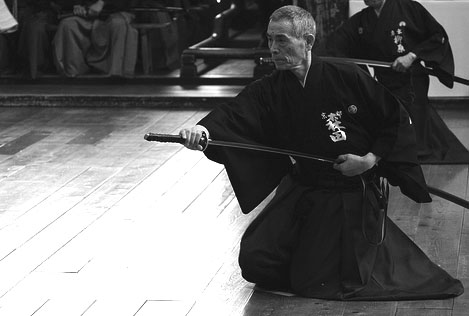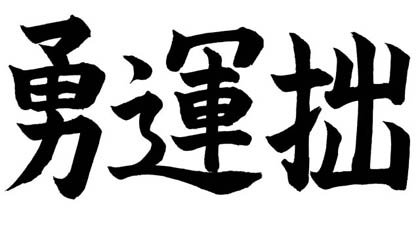The guidance of referee
 While intensively training, immersed in our day to day keiko slowly polishing the received teachings. It is always a good idea to dedicate some time to check your performance yourself, for example by filming and then judging your waza execution. Naturally follows the question: On what criteria should we judge a performance ?
While intensively training, immersed in our day to day keiko slowly polishing the received teachings. It is always a good idea to dedicate some time to check your performance yourself, for example by filming and then judging your waza execution. Naturally follows the question: On what criteria should we judge a performance ?
Well of course the ZNKR booklet kata’s points and riai respect is The base, but for middle and higher dan grades it is not enough and there is way more to check than just pure technique. In this context, I propose you the following post, largely using the first part of a document titled “The guidance of referee” which some of you maybe already own. The document starts with a recap of the points mentioned in the yellow ZNKR iaido regulation book and goes further in detail on the most likely to prove contentious points.
Points to consider when making a judgement (ZNKR Iaido regulation book)
The ZNKR rules and regulations for Iaido “Article 12” list the following points to consider when making a judgement.
1. Depth of practice.
2. Reigi, correct attitude and etiquette.
3. Technique:
(a) correct nukitsuke and kiritsuke
(b) correct sayabanare -the instant the sword leaves the saya- and hasuji
(c) correct chiburi
(d) correct noto
4. Kokorogamae: mental posture
(a) calmness
(b) metsuke
(c) spirit concentration, distance and timing
5. Ki/Ken/Tai no itchi: the mind, sword and body in harmony
6. Iai that has effectiveness as a martial art.
7. For further reference, the ZNKR Iai “Points to watch for in refereeing and judging”.
Of these points, number 1, 4 and 5 are most likely to prove contentious, so we will discuss them further. Questions will be how to judge the depth of practice, Kokorokamae and ki-ken-tai no itchi ?
How to interpret “Depth of practice”
a) Kurai dori
The original ZNKR Iai is intended to educate kendoka, and in the same way that shidachi in the kendo no kata should subdue the opponent by displaying a self confident attitude, it is equally important to show this kurai dori against an imaginary opponent (Kasso-teki).
b) Hin-i / Kigurai
The Iaidoka should show clearly that he is “pushing” the opponent with his spirit, thus overwhelming him.
c) Jo/Ha/Kyu
This is also called “Ma” and refers to the timing, or more accurately the balance between fast and slow movements, rhythm. This is a very important element, especially in a match between two high graded players.
d) Kaso-teki
This refers to the imaginary opponent. Does the player’s metsuke shows the correct number and position of the opponents ? Is the player cutting or thrusting to the correct targets ?
e) Cutting
One has to judge whether the cutting action is preceded with “Seme”, attacking attitude, and whether the monouchi of the sword is effectively used.
f) Sword sound
The sound that the sword makes should be short but sharp. The cutting movements can be divided into two parts; lowering the sword from above the head and the actual cutting. When the sword is just starting to move, no sound is preferable, but when the actual cut has started the there should be a sound until the swords stops.
g) Te-no-uchi
Of course there are both heavy and light swords. However it seems that recently strong swinging is seen as preferable to dynamic movement. A dynamic movement is always accompanied by a good te-no-uchi (the force concentrated to the monouchi) and simply swinging the sword forcefully should not be encouraged.
How to judge “Kokoro-gamae”
a) Calmness
A caml heart can be clearly seen in the eyes and attitudes of the player.
b) Metsuke
Metsuke shouldn’t only be taken to “Enzan no letsuke” but a distinction should also be made between “kan” looking with the heart, and “ken” looking with the eyes.
c) Spirit
The spirit of the Iaidoka should be so strong that the opponent is unable to draws his sword. If one has to draw, however reluctantly in order to preserve ones own life, then the cut must be fierce, determined and final.
d) zanshin
Correct zanshin should not be directed solely at one’s opponent but should be directed to all opponents in the vincinity.
e) distance and timing
To meet an opponent’s attack there will always be the consideration of timing and distance. Choosing wether strining before the opponent moves or reacting after one has invited the opponent to attack, will result in different timing and distance. It is therefore extremely important that the player shows that he is fully conscious of an opponent. Attention: In the case of the ZNKR Iai, only in Ukenagashi, kesagiri, soogiri and nukiuchi is the opponent invited to attack first. In all other forms one must strike the “degashira” of the opponent, that is, the very instant that he wants to start his movement.
What is Ki/Ken/Tai no itchi
The basic thinking of the ZNKR Iai is that the opponent can be restrained if one first takes the initiative. Therefore one has to move in a way which is dicated by the attack of the opponent. Consequently one should not cut after the feet have stopped moving but should rather let the body and sword together in harmony.
Morita sensei – Iaido 8th Dan Kyoshi.
Appendix
This list is not only dedicated to taikai/matches but is obviously also relevant for day to day renshu and examinations. A very interesting article, refining some of the complex concepts associated to Budo: Iaido, Jodo or Kendo … It also raised new questions, one of them focusing on the degashira explanation. In kendo terminology degashira and debana are generally associated and classified as part of the Shikake-waza. Going through some documentation the question revealed some interesting deeper aspects.
Posted: April 1st, 2011 under Article, Iaido.
Tags: Guide, referee, Shinsa



